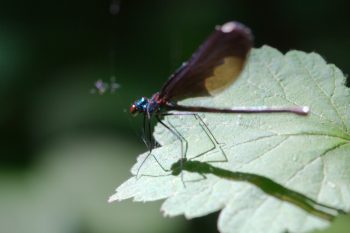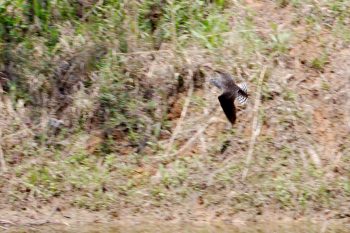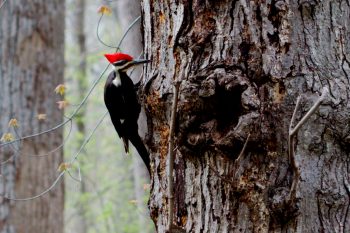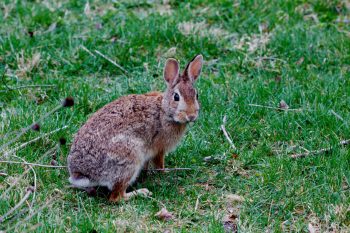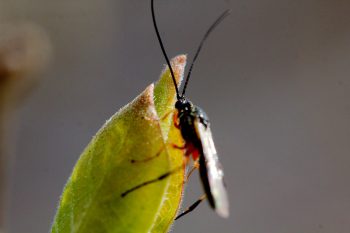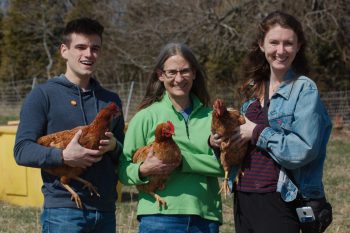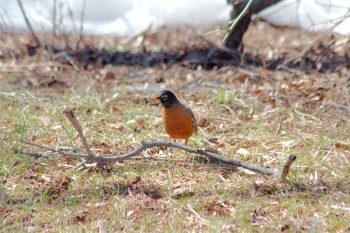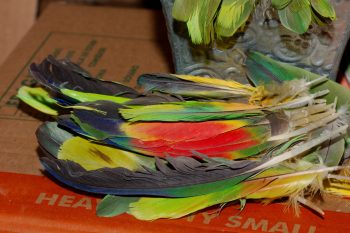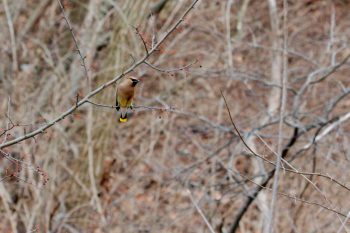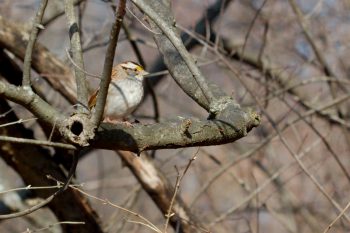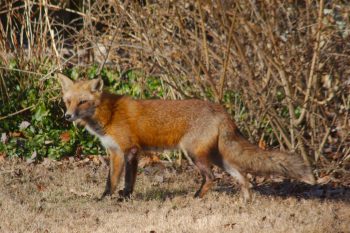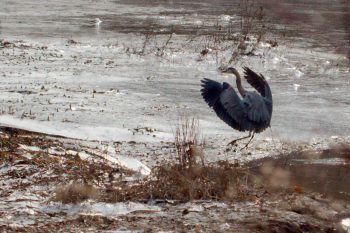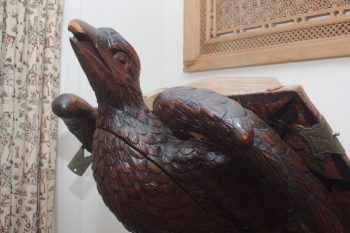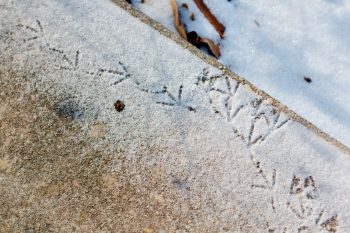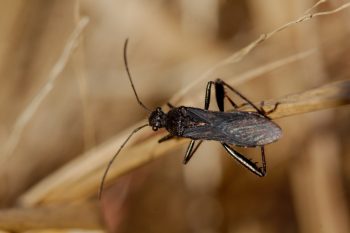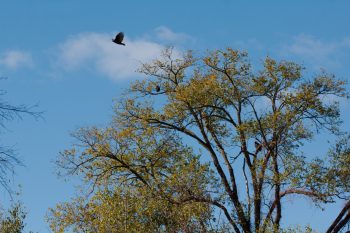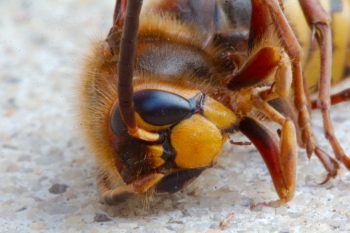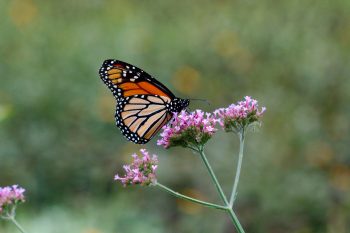I stopped on the way home today to take a short walk on Rock Creek Trail. I went over to the creek, where I had been a few weeks ago when the water was so high. There were quite a few insects about this time, including a lot of these pretty little damselflies. This is a male ebony jewelwing (Calopteryx maculata). The females have a conspicuous, white spot near the end of their wings (the “spot” on this one is a reflection, not really a spot). The photo is not as sharp as I would have liked but they don’t appreciate close approach and it’s the best I was able to get. One thing I really like about this picture, though, is that you can see the edge of the leaf through the damselfly’s wings.
Creatures
Solitary Sandpiper (Tringa solitaria)
I took a little walk at lunch time today, around my building and then into the woods. There is a tree that fell across the stream a year and a half ago and I’m still able to get across on that. One of these days it’s going to collapse under me, but so far, it’s been alright. There are a few drainage ponds on the upper part of the property and they have water in them now, even though our April was dryer than normal. I saw a bird across the pond and as if flew off I was able to get two pictures of it. Judging by its size and shape and with only a very brief glance at it, I had thought it was a killdeer (Charadrius vociferus). Once I saw the picture, though, I knew that was wrong. After a little searching, I decided it was a solitary sandpiper (Tringa solitaria), migrating to its summer breeding grounds in the far north (entirely north of the USA/Canada border). As usual when it comes to identifying birds, I checked with George to see if he thought I was right. He did.
Dryocopus pileatus (Pileated Woodpecker)
It was a beautiful day and Cathy and decided to take a short walk in nearby Rock Creek Park. With her ankle problems we didn’t want to overdo it, so this seemed like a good way to get out, at least a little. Before we had even gotten as far as the bike trail that runs along the creek we spotted this piliated woodpecker (Dryocopus pileatus), who landed on a tree not too far from us. We also saw a few white-tail deer (Odocoileus virginianus) (White-tailed Deer), including one that was seriously not bothered by our presence. We saw a small flock of cedar waxwings (Bombycilla cedrorum). There was also a nice assortment of wildflowers including star chickweed (Stellaria pubera), a pretty, little, white, star-shaped flower.
Eastern Cottontail (Sylvilagus floridanus)
It’s that time of year again. That time when all the rabbits appear. They’ve come out in pretty significant numbers and are ravenously eating our lawn and garden. I don’t mind when they eat the grass, that’s going to be cut anyway (eventually, once we can get to our lawn mower in the crowded garage). But eating the garden plants is another thing. That purple hyacinth that I posted a picture of recently is gone. They have eaten the tops off a few others, as well. I haven’t done anything to fight the rabbits for a long time but this time of year, I’m always tempted.
Spring
I took my camera with me to a meeting across campus and then spent a little time taking pictures on the way back. The Amur honeysuckle (Lonicera maackii) is starting to leaf out and in spite of the fact that it’s quite likely that we’ll have another freeze, it’s not at all bothered. It’s pretty well suited for cold and a light freeze or two isn’t going to do it any harm. This little insect, however, may be jumping the gun a bit. I don’t know, really. Perhaps it, too, has ways to deal with late freezes. I know some of my followers think it a bit funny that I try to identify all the plants and animals in my posts with their Latin names. You’ll be happy to know that I have no idea what sort of insect this is and I’m going to leave it at that.
Nobody Here But Us Chickens
As I mentioned yesterday, Dorothy is home for spring break and brought four friends with her. Today we drove out to our friends farm in the outskirts of Poolesville. The chicken’s are not really a featured attraction and visitors are not supposed to wander out into the field with the animals. One advantage of being friends with the owners, however, is a little more latitude when it comes to where we are allowed. The kids (and I’m counting Cathy among them) enjoyed catching chickens and putting them back inside the enclosure. Here are John, Cathy, and Grace, each with a chicken.
American Robin (Turdus migratorius)
With a specific name like Turdus migratorius, you might thing the American robin is only here part of the year. After all, migratorius implies it migrates. Well, it does. Nevertheless, for the overwhelming part of the 48 contiguous states, the robin is a year-round fixture. Their summer breeding grounds extend from the southern states (and include the mountains of central Mexico) to cover all but the most arctic portions of Canada. In the winter they move south, with their northern limit right around the U.S.-Canadian border. So, if you live in Canada, their arrival is a sure sign of spring. The birds we see in the summer may not be the birds we see in the winter but frankly, they all look pretty much alike. We often see them eating berries on the holly in our front yard. This time of year, as it begins to warm up, they are active pulling up worms, as this one was doing before being so rudely interrupted by me.
Parrot Feathers
Cathy’s brother is in town and we’ve begun to work on their mom’s house today. It’s going to be a longish process and there will be parts of the process that are going to be quite difficult. Today we were just beginning to scratch the surface of 50 years of things, some of which brought back happy memories for them and some less so. In one drawer I came across a plastic grocery bag full of parrot feathers. The cleaning lady would collect them and make them into crafts. None of us are particularly fond of the crafts, although we appreciated the sentiment. The parrots are gone (Red and then Roscoe have past on to that great bird cage in the sky. Caesar is living with dozens of other birds and apparently now is palling around with two toucans (fourcans?). These feathers went into to the trash.
Cedar Waxwing (Bombycilla cedrorum)
It rained overnight but was mostly clear today and quite warm for mid-February. After a meeting that ran from 11:30 to just before noon, I walked a bit in the woods and upland area next to my office. First, I walked down into the woods above the drainage pond where a fair sized flock of cedar waxwings (Bombycilla cedrorum) were bouncing around in the underbrush. If I had a tripod and a longer lens I think I could get some pretty good photos in that area. As it is, this is good enough for identification purposes but it isn’t going to win any awards. Still, it was nice to be out with the birds in 60°F weather in the middle of winter.
White-throated Sparrow (Zonotrichia albicollis)
I had a dentist appointment this morning and that meant that I got to work a little later than normal. It was cool out but sunny and bright. As I Parked the car at work I saw a red-bellied woodpecker (Melanerpes carolinus) fly past and land on a tree across the parking lot. I got my camera out and walked towards it. I got one picture from a fairly large distance but for the most part it kept to the far side of the tree it was on and eventually it flew away. I spotted this white-throated sparrow (Zonotrichia albicollis) and managed to get quite a bit closer. It’s a cheerful little bird, and quite pretty with its yellow patch (and of course its white throat).
Red Fox (Vulpes vulpes)
I was up before sunrise this morning and wasn’t really looking outside until after Cathy got up. When she came down and went into the kitchen, she called me (quietly) and said there was a fox on our back patio. She had put some old sunflower seeds out on the ground, thinking they would be eaten by squirrels and birds, but the fox was happily eating them. After a while it moved away to the back of the yard and then curled up in the grass for a while. Unfortunately it did that in a spot mostly hidden by a tree. I didn’t want to go outside, as that would surely have scared it off. Eventually it got up and walked around a little before taking off for parts unknown. I suppose if we had a small dog I’d be more worried about seeing the fox, but as it is, it made us glad.
Great Blue Heron (Ardea herodias)
After a meeting across campus today, I stopped to take some pictures of the ice around the drainage control pond next to my building. With the rain on Thursday and Friday, the water had been high. As it drained, the temperature dropped and it froze, but the water level continued to drop, leaving lots of ice around the banks of the pond. As I walked down through the middy area leading to the pond, this great blue heron (Ardea herodias), took off and flew a little further away from me. After that, he waded around and I was able to get a few more pictures, both from this side (where he is back lit) and from the other, with the sun shining on him from over my shoulders. Without more than a 100mm lens, this is the best I could do.
Eagle Lectern
Back on Wednesday, January 23, 2013 I posted a photo titled “Lectern Eagle’s Talons” which was a portion of a wooden lectern carved in the shape of an eagle. This is the head of the eagle, which unfortunately has a chipped beak. There is also a large crack across the breast of the bird, but that adds character more than anything. Otherwise, it’s in pretty good shape. There was, at one time, a brass plaque (I’m assuming brass) which probably said who paid for the lectern or something of that sort. There really needs to be a small set of steps behind this, so you can get up high enough to read from it, as the whole things is well over six feel tall.
Bird Footprints
We had a light snowfall overnight. The forecast is for clear or mostly clear skies for a while so we aren’t likely to get more but the forecast is also for relatively cool temperatures for the next week or so, probably below 20°F for the duration and getting well down into the single digits. I’ll probably need to wear a sweater one or two days this week. These footprints are on the back step, just outside our kitchen door. We have a birdbath with a heater in it that keeps the water from freezing, so birds are never in short supply this time of year, particularly when it gets to cold.
Alydus eurinus (Broad-headed Bug)
It was a gloriously beautiful day today and I had a little time for lunch so I went out into the empty lot next to my building and lay on my back in a patch of dry grass. The sky was a beautiful blue. The sun was warm but the air was cool, so it was perfectly comfortable. While I was sitting, this little bug flew up and landed on a blade of grass right in front of me. I was able to get a handful of pictures, although they are not as sharp as I’d like. I had to take it from a slightly awkward sitting position. When I tried to lie down to get a better position, I scared it off.
Turkey Vultures (Cathartes aura)
I was outside for a little while today and took a few pictures. Most of them were of trees reflected in the windows on the outside of my office building. They are not as colorful as in some years but with the blue sky behind them and the slight distortions of the not-quite-flat glass, they made for interesting pictures. Then I noticed a vulture land in this tree. I took two pictures of the tree in reflection and then turned around to get a couple directly. There are three birds in the tree and just after I snapped one picture, a fourth turkey vulture flew through the frame and I grabbed one more shot. Actually, I’m not sure they are all turkey vultures. At least one may be a black vulture (Coragyps atratus).
Vanessa cardui (Painted Lady)
The buddleia in the back and side yards is going to be done blooming soon but while there are still flowers on it, the butterflies are making the most of the time they have left. There were dozens of painted ladies (Vanessa cardui) in the yard today, as well as a handful of monarchs (Danaus plexippus). I got a few pictures of both together but since I’ve posted monarch pictures recently and it’s been a few years since I featured a painted lady, I decided to go with this one, which I think shows it off pretty well.
Vespa crabro (European Hornet)
I went out back to see what I could find to photograph this evening. There was a painted lady (Vanessa cardui) butterfly on the Buddleia and I got some reasonable but not great pictures of that. Then I noticed this large, yellow and brown wasp on the steps. This is a large wasp, about 2cm in length. Not as big as the eastern cicada killer (Sphecius speciosus) but still a pretty good size. As the common name implies, these are native to Eurasia. They were introduced to eastern North America in the 1800s. They are one of the many wasps to build paper nests out of chewed wood pulp.
Another Monarch
IN general I try not to post pictures of the same thing close together and especially not two days in a row. However, needs must. I only took a few pictures today and the only pictures worth sharing from today are of a monarch butterfly (Danaus plexippus) in our back yard. This one doesn’t have the orange flower complimenting the butterfly but it’s still pretty nice, I think. These are here in pretty good numbers right now, and I’m really enjoying them on the Buddleia and (like this one) the Verbena bonariensis.
Monarch of the Glenns
We had a short visit from Dorothy this weekend. She flew down to Richmond late Thursday evening and came up here this morning for a less-than-24-hour visit. We went out to the Glenn’s farm (properly known as Rocklands Farm) and while we were there I got some pictures of a monarch (Danaus plexippus) on Anna’s flowers. We enjoyed being outdoors although truth be told, it was a bit warmer than is my preference. Still, a beautiful day.

